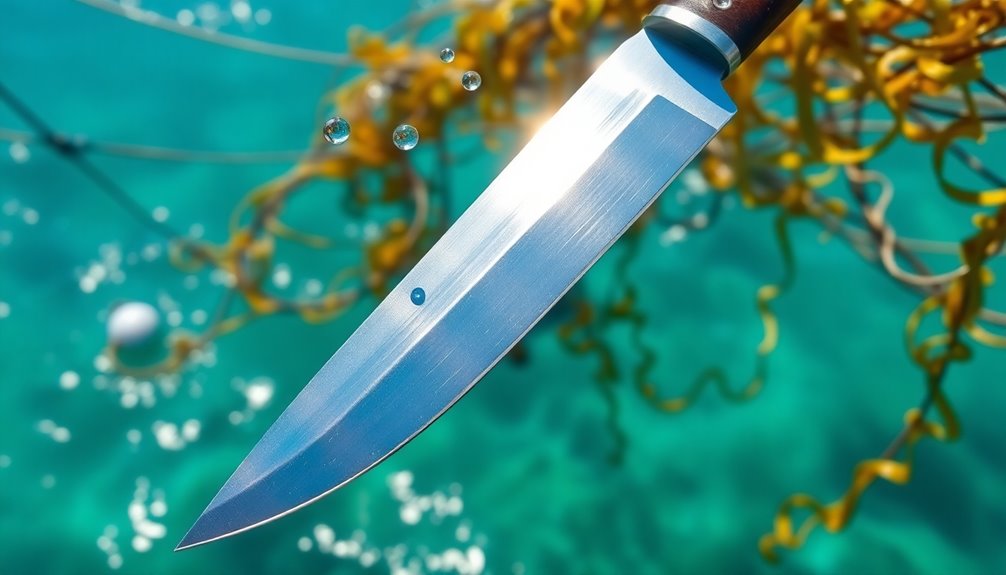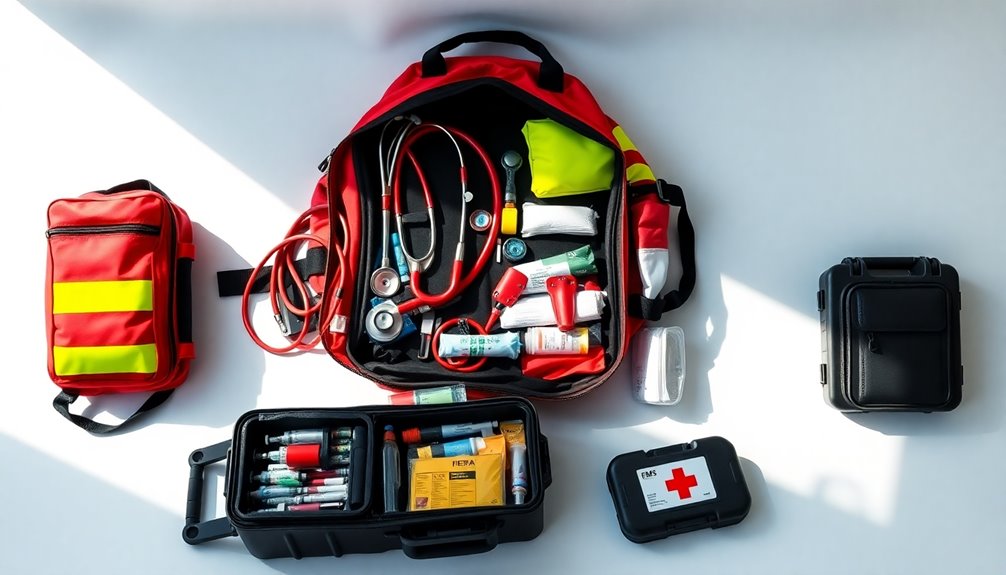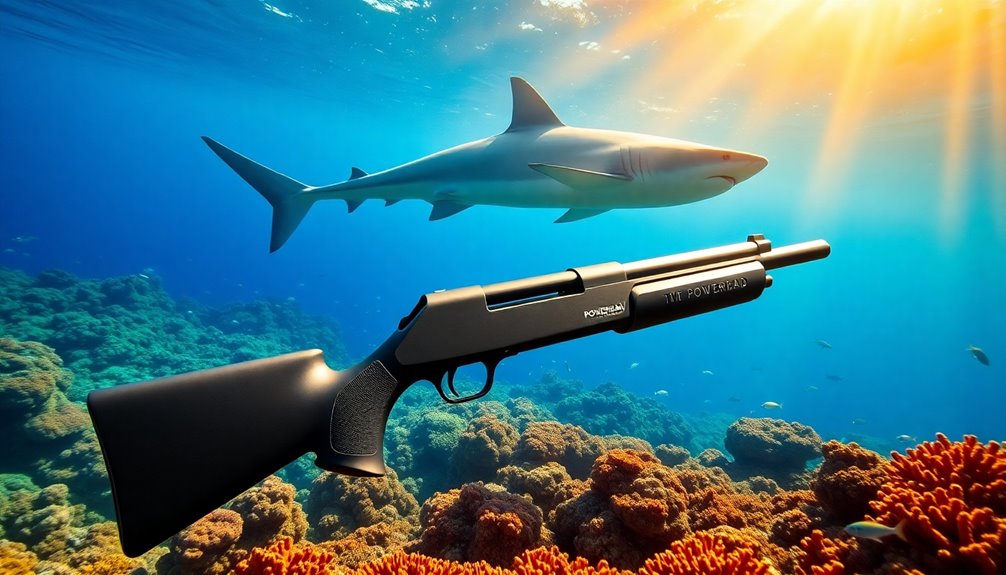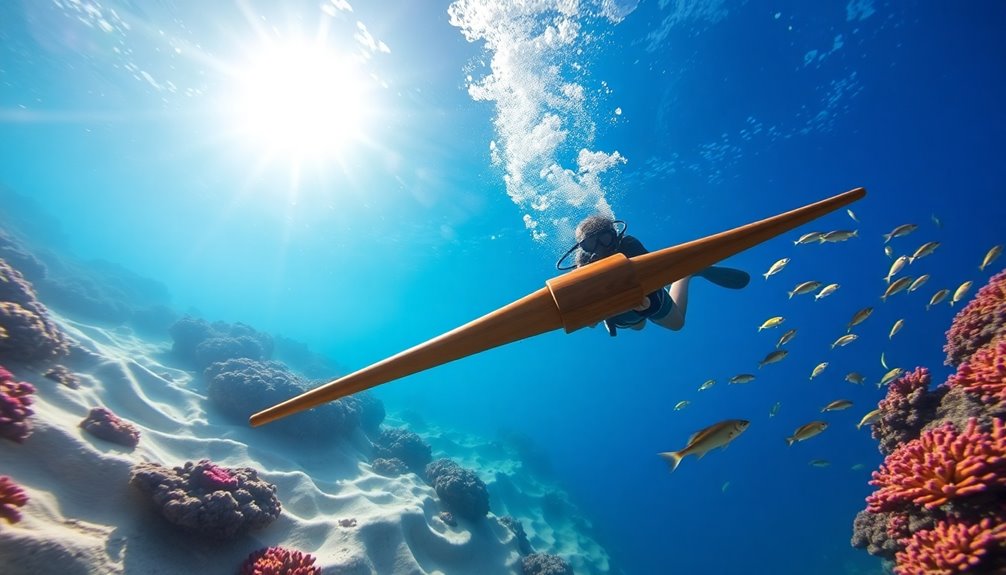A spearfishing knife is your ultimate tool for cutting through nets, lines, and obstacles with ease! Look for strong materials like titanium or marine-grade stainless steel, which won't rust. Choose a blade length between 4 to 8 inches for the perfect balance underwater. Having a serrated edge helps tackle tough stuff, while a snug, ergonomic handle makes it comfortable to grip, even with gloves. Most importantly, make sure it's in a secure sheath for safety. With proper care, like rinsing it after each dive, your knife can last for countless adventures. You're going to discover even more useful tips next!
Key Takeaways
- A serrated blade edge excels at cutting through tough materials like nets and lines quickly and efficiently.
- A narrow tip enhances penetration, allowing you to tackle obstacles with precision and ease.
- Lightweight materials, such as titanium, ensure the knife is easy to maneuver in challenging underwater conditions.
- Blade lengths between 4 to 8 inches strike the perfect balance for cutting power and control.
- Ergonomic handles provide a secure grip, reducing slippage and improving overall cutting performance when tackling obstacles.
Essential Knife Materials
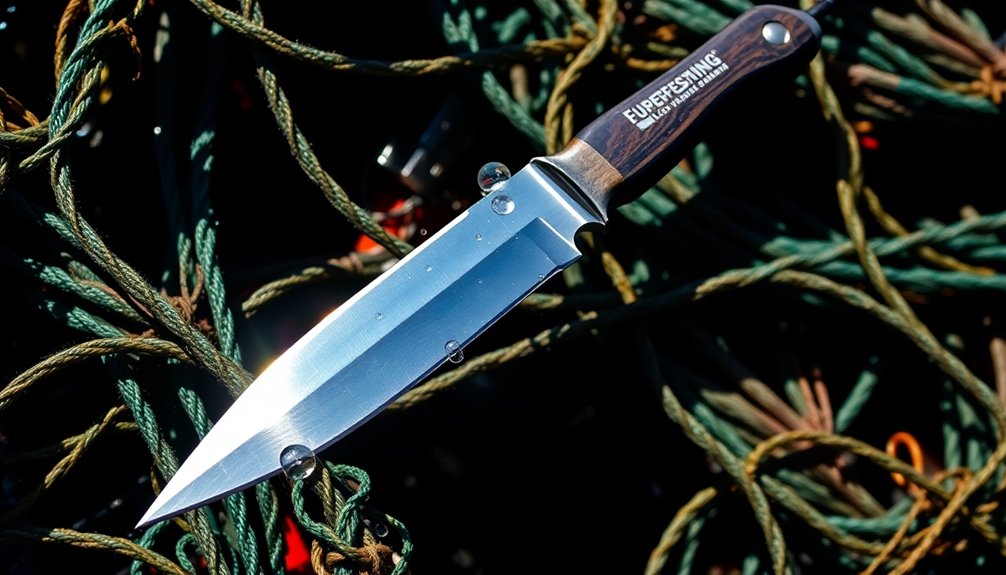
When choosing a spearfishing knife, the materials used in its construction play a crucial role in performance and longevity. You've got two main options: titanium and steel.
Titanium blades are super strong, lightweight, and never rust! That makes them perfect for saltwater adventures. Plus, they're easy to handle underwater, so you can slice through nets and lines without feeling weighed down.
On the other hand, steel blades are easier to sharpen, but they need a bit more TLC to keep from rusting. If you pick a steel knife, remember to dry it off after every dive and store it properly. Marine-grade stainless steel is a great choice if you want a balance of strength and corrosion resistance. Additionally, many knives are made from durable marine-grade stainless steel, which ensures they withstand the rigors of underwater use.
Some knives even use aircraft-grade titanium alloy, which is tough and keeps a sharp edge, making it a fantastic pick!
Single-piece steel designs ensure your knife and handle are sturdy, ready for any underwater challenge.
In the end, the right material sets the stage for your spearfishing success, so choose wisely and enjoy your underwater escapades! When selecting the right material for spearfishing, it’s important to consider not only the wetsuit, fins, and speargun, but also the dive mask and snorkel. These items are crucial for clear visibility and efficient breathing while submerged. Investing in high-quality, well-fitting gear will enhance your overall spearfishing experience and help you make the most of your time underwater.
Key Blade Features
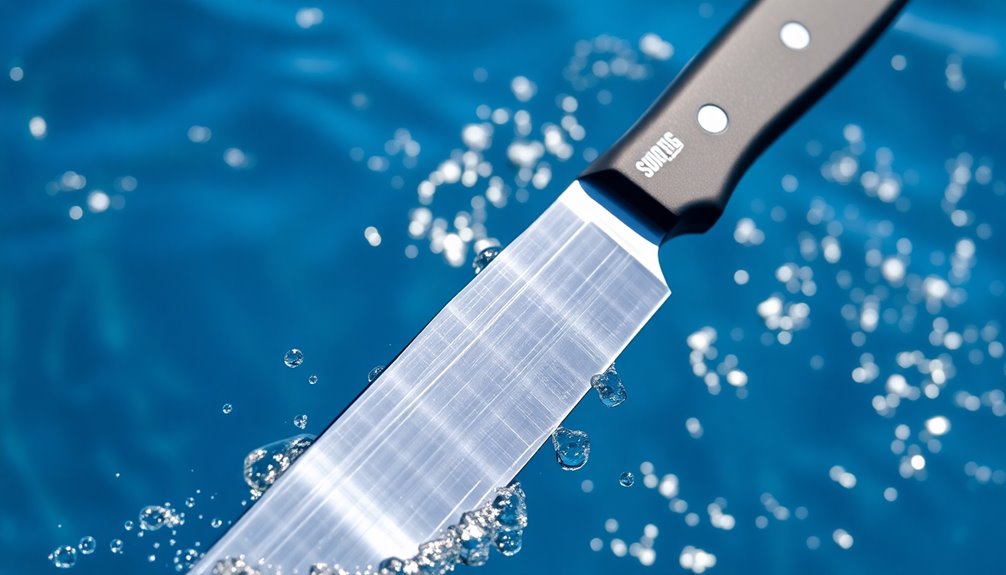
Choosing the right materials for your spearfishing knife lays the groundwork, but specific blade features can significantly enhance your underwater efficiency.
First, let's talk about blade types! A serrated edge is perfect for slicing through tough materials like fishing lines and nets, while a sharp point helps you dispatch fish swiftly. Some folks prefer a blunt tip for safety, but that's up to you!
Now, think about blade length. Knives between 4 to 8 inches are best because larger ones can feel heavy underwater. A narrow tip allows better penetration, and a curved cutting edge gives you more surface area for tasks like cutting bait. Additionally, consider the blade design to ensure it matches your intended use, whether for safety or utility.
Special features, like a line hook, can quickly cut through tangled fishing lines, making your life easier. Plus, a safety edge on the back keeps you safe when you're working underwater.
Lastly, durability is key! You want a knife that can handle all your adventures without dulling quickly.
Ergonomic Design Considerations

To maximize your underwater performance, ergonomic design considerations for your spearfishing knife are essential.
First off, you want a handle that fits snugly in your hand. Imagine holding a slippery fish—your knife should have a grip that feels secure, even with thick dive gloves on! Look for anatomical grips, like those on the Pathos Sting, which help keep your fingers in the right spot, preventing slippage and fatigue. This is important because ergonomic designs help prevent repetitive strain injuries (RSIs) in frequent users.
Next, think about balance and weight. A good knife won't feel heavy; it should be light enough to use easily but still give you control. You want it to feel like an extension of your arm. Compact knives, such as the Pathos Sting, are fantastic for this, easily maneuverable underwater.
Finally, consider the materials. A handle made from rubberized grips or marine-grade stainless steel will stand up to saltwater while feeling comfortable in your hand.
Don't forget about accessibility—your knife should be easy to reach, maybe strapped to your calf, so you can grab it quickly when needed. With these ergonomic features, you're all set for a successful spearfishing adventure!
Safety Mechanisms
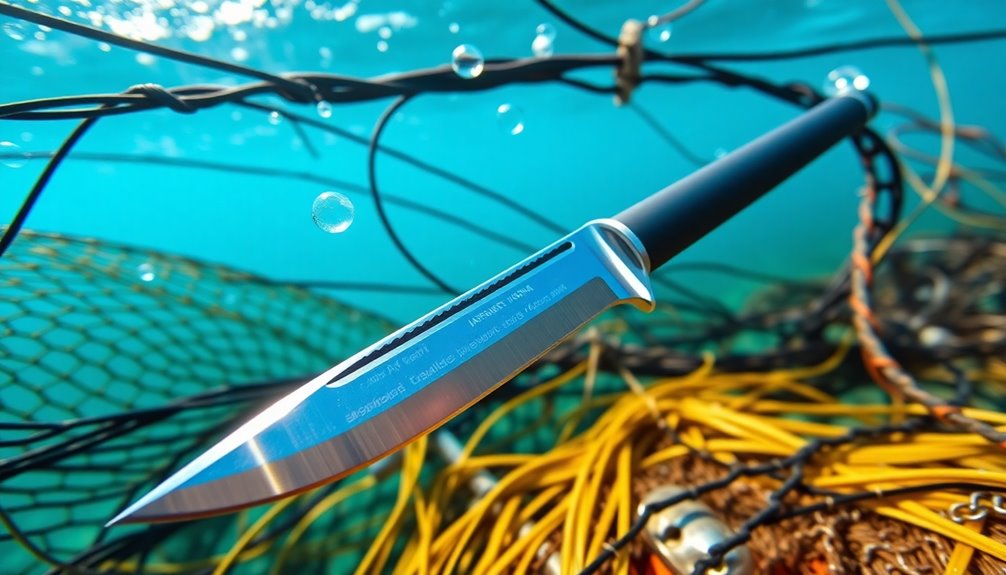
Ensuring safety while spearfishing requires robust safety mechanisms for your knife. You want to make sure your knife is secure in its sheath, right? Look for sheaths made of tough technopolymer or flexible plastic, as they're durable and can handle the underwater world.
With elastic rubber rings and adjustable straps, your knife will stay in place until you need it. Plus, twin snap clips add extra security, so no worries there!
When you're in an emergency, quick access is key! Opt for a knife that's compact and easy to reach, whether it's clipped to your calf or weight belt. You don't want to waste time fumbling around when every second counts.
Accidental deployment is another concern, but don't fret! Safety catches and locks, like thick O-rings, help keep your knife secure in its folder.
With anatomical grips and handles, you'll reduce the chances of slipping and hurting yourself. Additionally, many dive shops offer a diverse range of diving gear and accessories to ensure you have the best tools for your underwater adventures.
Lastly, the blade design matters too. Look for marine-grade stainless steel blades with serrated edges that cut cleanly through nets without causing punctures. Rounded tips mean fewer accidents, so you can focus on your spearfishing adventure safely!
Maintenance Tips for Longevity
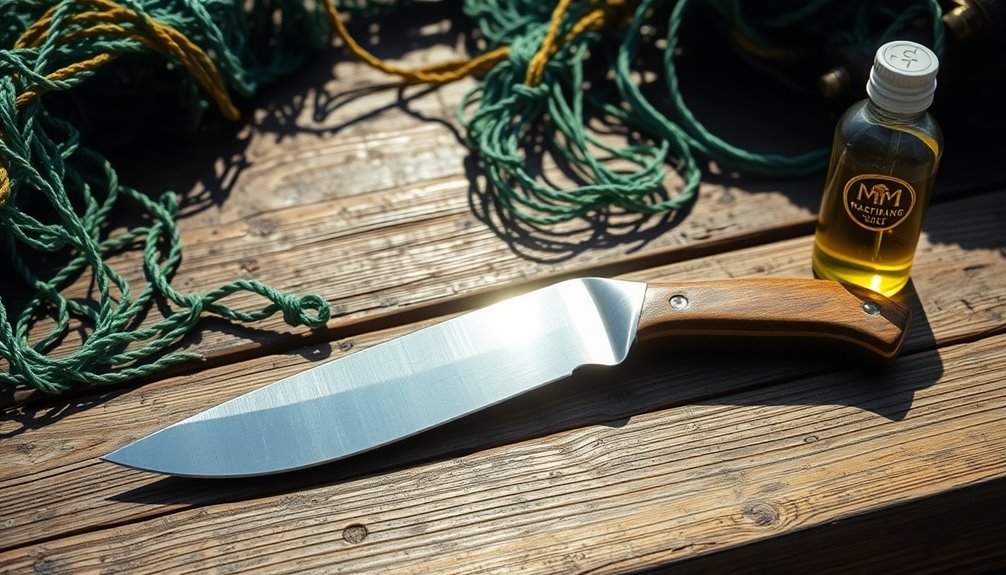
Before you head out for your next spearfishing adventure, taking a few minutes to maintain your knife can significantly extend its lifespan.
First, check for any signs of corrosion on the blade and locking mechanism. If you spot light corrosion or buildup, just grab a towel or an old toothbrush to clean it off. Make sure the locking mechanism works smoothly, and if it doesn't, a little silicone lubricant can work wonders!
After your dive, it's crucial to rinse your knife thoroughly with fresh water to wash away salt and debris. Regular maintenance extends the lifespan of your knife, ensuring it performs optimally during your next dive.
Don't forget to take it out of its sheath and move any parts while soaking—this helps dislodge stubborn sand. Once dried, apply a light coat of silicone to keep corrosion at bay, steering clear of petroleum-based lubricants.
When storing your knife, keep it in a dry spot, away from sunlight and moisture.
Regularly inspect for rust, and if you find any, steel wool or scotch brite with WD-40 can help.
Lastly, don't forget to sharpen your knife now and then to keep it ready for action!
Happy diving, and keep that knife in tip-top shape!
Frequently Asked Questions
What Is the Best Blade Length for Spearfishing Knives?
When choosing the best blade length for your spearfishing knife, think about comfort and ease of use!
A blade between 3 to 5 inches is perfect because it's manageable and versatile. If it's too long, it might feel clunky underwater, and nobody wants that!
A medium blade, around 4 inches, helps you tackle most tasks smoothly. Plus, a sharp tip is great for catching fish, making your underwater adventures even more exciting!
Can I Use a Spearfishing Knife for Other Water Activities?
Absolutely! You can use a spearfishing knife for other water activities.
It's perfect for cutting tangled lines while kayaking or fishing, and it's handy for opening clams or other shellfish.
Plus, if you find yourself in a bit of trouble, it can help signal for help!
Just remember to keep it sharp and clean, so it's ready for action whenever you need it.
Dive in and enjoy your adventures with your trusty knife!
How Do I Choose a Knife Based on My Diving Experience?
When you're choosing a knife based on your diving experience, think about what you'll need!
If you're a beginner, a lightweight, easy-to-handle knife is best. Look for features like a secure grip and a compact design so you can use it easily underwater.
As you gain experience, you might want a knife with more versatility, like dual edges for different tasks.
What Are the Benefits of a Serrated Edge on a Spearfishing Knife?
A serrated edge on your spearfishing knife is super handy! It slices through tough fishing lines, nets, and even seaweed like a champ.
Those little bumps, or serrations, grab onto the material, making cutting easier—especially when things get tangled. Plus, if you're in a pinch, it helps you cut quickly, keeping you safe underwater.
With proper care, your serrated knife will last, ready for all your underwater adventures. Isn't that awesome?
Are There Specific Brands Known for High-Quality Spearfishing Knives?
When you're searching for high-quality spearfishing knives, several brands stand out!
Cressi is known for its durable blades and handy features, like the Cressi Killer and Lizard models.
Then there's the Pathos Sting, with its sharp, marine-grade steel.
Don't forget about Mares and Riffe, who both offer excellent options with comfy grips and strong blades.
Choosing the right knife can make your underwater adventures even more exciting and fun!
Conclusion
So, when you're ready to dive into spearfishing, remember that the right knife can make all the difference! With strong materials, sharp blades, and a comfy grip, you'll tackle any net or line with ease. Plus, don't forget to keep it clean and safe! Your spearfishing adventures will be even more exciting when you've got a trusty knife by your side. Happy fishing, and may your catches be as big as your smiles!

